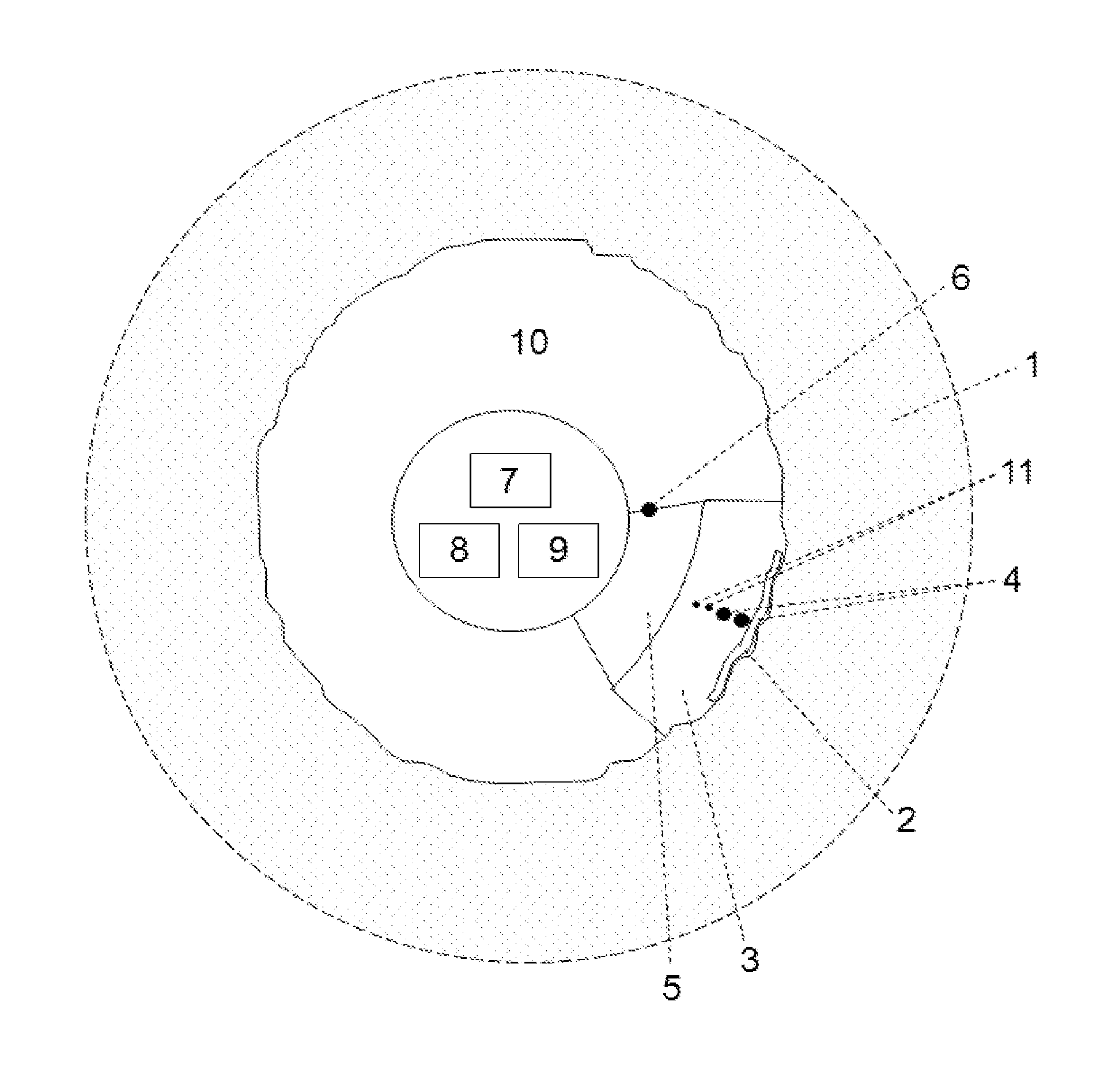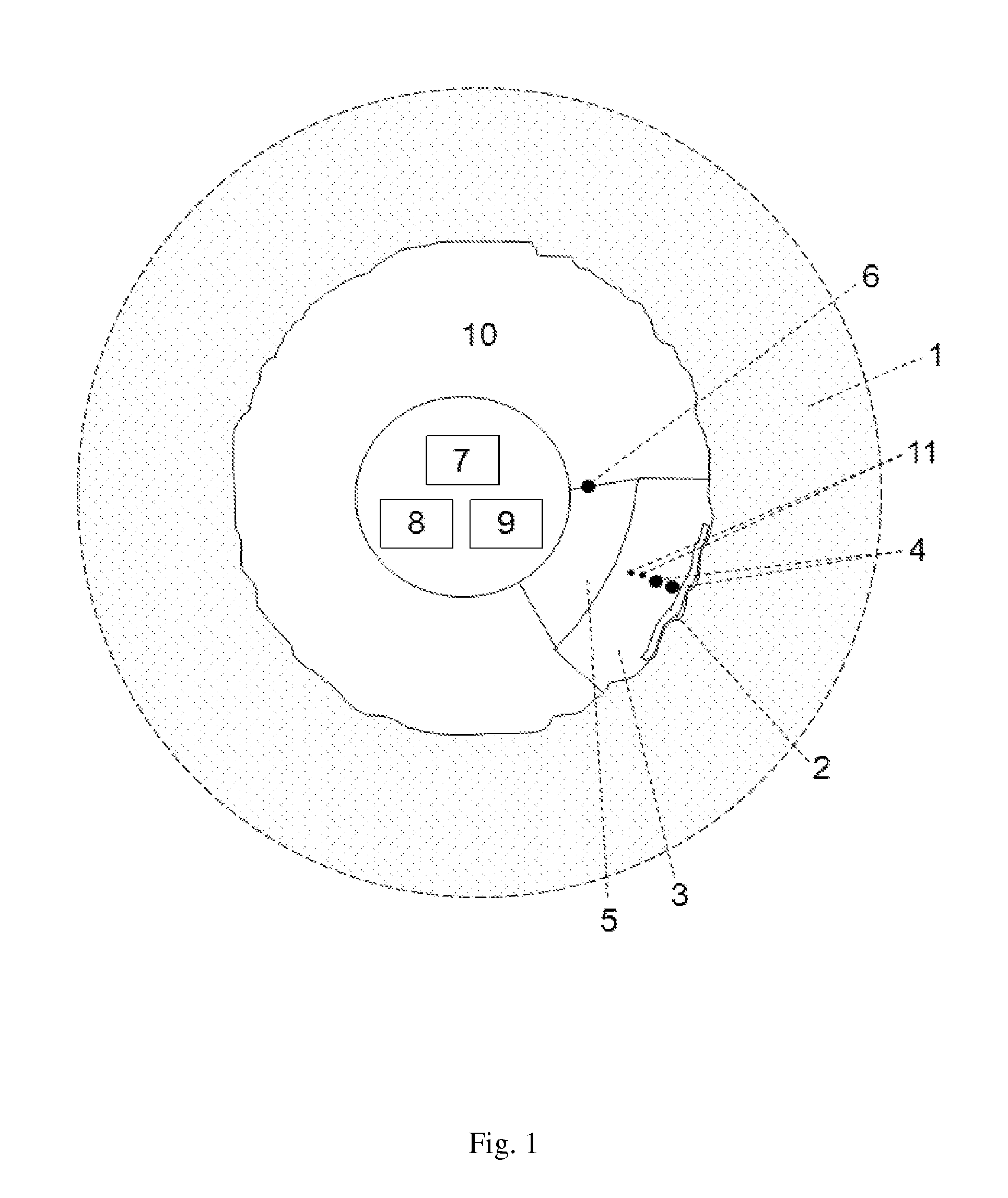The main
disadvantage of the known method consists in the fact that complicated
processing of measurement data is required in case of the pulse heating, which reduces the measurement accuracy and increases considerably the
measurement cost.
However, this method has serious disadvantages which limit its area of application.
These disadvantages include a low accuracy of measurements taken on cylindrical, conical, spherical, elliptical, rough and irregular surfaces, as well as in wells filled with fluid.
These disadvantages result from the fact that the heater temperature is registered not on the entire heater surface in contact with the solid body, but only in the small area where a point temperature sensor is located, and that it is impossible to achieve the required
thermal contact of the heater and the temperature sensor with the solid body throughout the heater surface and the temperature sensor surface.
The measurement process is limited by the heater's operating period only, and it is impossible to take into account the heat loss from the heater into the adjacent heat insulator, which is necessary for the registration of the changes in the contact
thermal resistance between the heater and the solid
body surface.
A serious
disadvantage consists in the fact that the measurement data may be considerably distorted due to the effect of the thermal
convection (which is inevitable in case of a heat source present in the well fluid), and that the equation used as an
algorithm for
processing the
signal and for converting the
signal into the data on the thermal
conductivity and thermal diffusivity of the solid body is not sufficiently adequate to the physical conditions of the measurements because it does not take into account the heat loss from the heater into the heat insulator and a considerable effect of the contact
thermal resistance between the heater and the solid body.
Lastly, another serious
disadvantage of this method, when used for measuring the thermal
conductivity and thermal diffusivity of heterogeneous bodies, consists in the fact that the point temperature sensor is located in one small area (in one point, practically) and responds to the temperature of this small area only.
This gives a considerable
distortion of the measurement data for the rock which is essentially heterogeneous due to its
granularity, fracturing and local variations in the
porosity, and makes the measurement data unrepresentative for the total heating area.
The disadvantages of this device include a low accuracy of measurements in case that the device is used for measuring the thermal
conductivity and thermal diffusivity on cylindrical, conical, spherical, elliptical, rough and irregular surfaces, as well as in wells filled with fluid, and the impossibility to achieve a satisfactory
thermal contact between the sonde and the medium's wall due to the flat shape of the sonde.
Another serious disadvantage of this device includes the distorting effect of the thermal
convection of the well fluid, which is possible when the heat from the heater propagates into the surrounding fluid too, thus initiating the convective motion of the fluid and distorting the measurement data.
Another disadvantage of this device includes the inconsistency between the theoretical model of the measurement method, developed for using the sonde on flat surfaces of solid bodies, and the real conditions of the measurements taken on solid bodies with non-flat and / or rough or irregular walls.
As a result, it is impossible to take into account the effect of the hole wall surface curvature on the thermal conductivity and thermal diffusivity measurement data.
This device has serious disadvantages which reduce considerably the accuracy of the measurements of the solid body's thermal conductivity and thermal diffusivity and narrow considerably its area of application.
Such serious disadvantages include an unacceptably low accuracy of the measurements of the solid body's thermal conductivity and thermal diffusivity, taken on cylindrical, conical, spherical, elliptical, rough and irregular surfaces.
The same disadvantage applies to the measurements taken in wells, because this device cannot limit the distorting effect of the thermal
convection of the well fluid, which occurs when the flat heater is in operation and when the heat is transferred from the flat heater not only to the solid body, but also to the fluid through the heat insulator, the sonde body and the hold-down unit used for holding down the sonde body.
Besides, this device is unable to provide the required accuracy level because it does not take into account the effect of the contact
thermal resistance on the measurement data.
Another considerable disadvantage of the device consists in the fact that it is impossible to take into account the effect of the shape and irregularities of the solid body surface on the results of the measurements of the solid body's thermal conductivity and thermal diffusivity.
The disadvantage of this device, when used for measuring the thermal conductivity and thermal diffusivity of heterogeneous bodies, consists in the fact that the point temperature sensor is located in one small area (in one point, practically) and responds to the temperature of this small area only.
This gives a considerable
distortion of the measurement data for the rock which is essentially heterogeneous due to its
granularity, fracturing and local variations in the
porosity, and makes the measurement data unrepresentative for the rock volume corresponding to the heating area.
 Login to View More
Login to View More  Login to View More
Login to View More 

